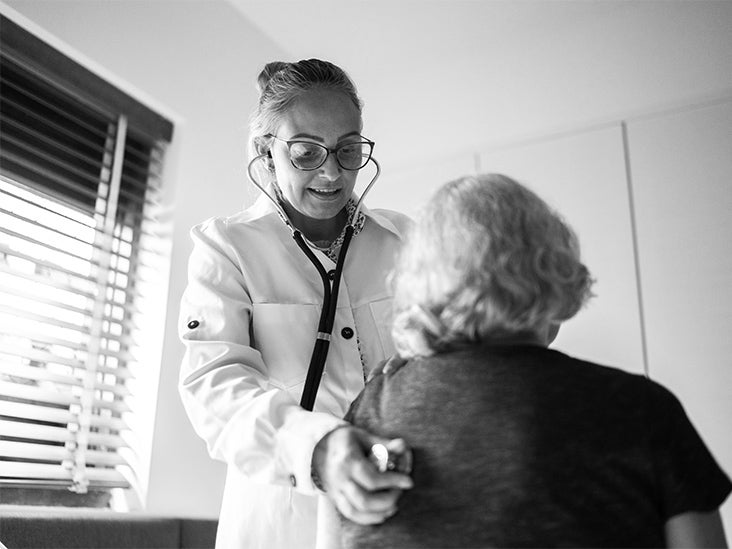What is lung scraping for COPD, and who may need it? - Medical News Today

Lung scraping, or thoracentesis, involves the removal of fluid or air from the space between the chest wall and the lungs. In some cases, doctors may perform the procedure on people who have chronic obstructive pulmonary disease (COPD).
It is not a standard treatment for COPD, but it may be necessary if a person has pleural effusion or empyema.
This article looks at COPD and lung scraping in more detail. It explains who may need the procedure and discusses the risks, preparation, and aftercare. It also outlines other procedures for COPD.
Lung scraping
Therapeutic thoracentesis helps decrease the shortness of breath and pain that result from the pressure of the fluid on the lungs. It typically involves the removal of a large volume of fluid. It is not unusual for a healthcare professional to remove
Diagnostic thoracentesis helps doctors determine the cause of pleural effusion, which is a buildup of fluid in the pleural space. Healthcare professionals remove less fluid during diagnostic thoracentesis.
Doctors
Thoracentesis is not generally a primary treatment for COPD. However, doctors may suggest thoracentesis for a person with COPD who develops pleural effusion or empyema.
An empyema involves an accumulation of pus in the pleural space. In the U.S., there are about
A
Thoracentesis is an option for people with COPD who develop an empyema. It is also a treatment option for pleural effusion that is not related to COPD. According to
It is important to emphasize that thoracentesis is not a treatment for COPD. Rather, it is a procedure for draining fluid from the pleural space.
As with any medical procedure, thoracentesis has risks. According to the American Thoracic Society, possible risks include:
The risks of complications may vary based on several individual factors, including the amount of fluid in the pleural space.
The researchers behind a recent study investigated the complication rate of thoracentesis over a 5-year period. They looked at a total of 685 thoracentesis procedures and found a complication rate of 4.1%, equating to 28 complications.
A
To prepare for thoracentesis, doctors may instruct a person to stop eating and drinking for a specific number of hours before the procedure. A person may also be unable to take certain medications on the day of the procedure.
Healthcare professionals may give different preparation instructions to each individual depending on their circumstances.
Typically, doctors will perform an imaging test before the procedure to determine how much excess fluid is in the pleural space. A doctor may use one of the following imaging tests:
Usually, people remain awake during thoracentesis. Sometimes, a doctor may give a person sedative medication to help them relax.
After cleaning a person's skin with a disinfectant, the healthcare professional will inject a numbing medication into the skin.
To perform the procedure, the doctor will insert a thin tube or needle through the skin and the chest wall into the pleural space. They will then remove the excess fluid through the tube and remove the tube when all the fluid has drained.
The procedure usually takes
After removing the tube, the doctor will apply a bandage to the insertion site wound. The small wound should close by itself without the need for stitches.
Anyone who takes sedative medication to help them relax during the procedure will need someone else to drive them home.
The
Healthcare professionals may recommend avoiding or doing certain things to avoid infection and other complications. Their recommendations may include:
- showering rather than taking a bath until the puncture site has healed
- avoiding strenuous activity
- resting when tired
- checking when to resume regular medications
- taking antibiotics if a doctor has prescribed them and completing the full course
- keeping the puncture site clean and dry
Typically, COPD treatment includes medications, oxygen therapy, and lifestyle changes. Doctors may also suggest surgery.
In certain circumstances, a doctor may recommend thoracentesis for pleural effusion or empyema related to COPD.
However, healthcare professionals use other surgical procedures to treat COPD. According to the ALA, the following surgical procedures may be an option for people with COPD:
- Bullectomy: In this procedure, a doctor will remove bullae, or large air sacs, from the lungs. The bullae may block or interfere with functioning lung space and cause difficulty breathing.
- Lung volume reduction surgery: This may help in cases of severe COPD that affects the upper lobes of the lungs. A healthcare professional will remove about 30% of the damaged lung tissue. This allows the healthier portion of the lung to work better.
- Lung transplant: In cases of severe COPD, lung transplantation may be an option. A doctor will remove the damaged lung and replace it with a donor's lung.
Lung scraping is a medical procedure in which a doctor removes excess fluid from the space between the chest wall and the lungs. Healthcare professionals will likely refer to lung scraping as thoracentesis.
Thoracentesis is not a standard treatment for COPD. However, doctors may use thoracentesis to treat pleural effusion or empyema, which may occur in people with COPD.
A person with COPD should discuss their treatment options in detail with a doctor.
Comments
Post a Comment